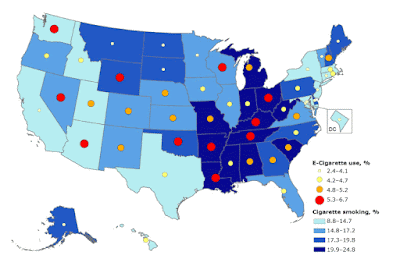Although smoking rates in America have improved over the past few decades, 12 states from the upper Midwest to the South still see concentrated tobacco consumption. According to CNN, the nonprofit organization Truth Initiative first released its report on what they dubbed the "Tobacco Nation" five years ago, but the numbers persist. Spanning Alabama, Arkansas, Indiana, Kentucky, Louisiana, Michigan, Mississippi, Missouri, Ohio, Oklahoma, Tennessee, and West Virginia, the region sees a smoking prevalence about 50% higher than the rest of the country.
These statistics are alarming, but such a significant disparity can be traced primarily to lapses in policy. Here's what you need to know about why the 12 states of the Tobacco Nation smoke more.
Why smoking is more prevalent in these states
With smoking being the leading cause of preventable death worldwide, the Tobacco Nation presents an alarming threat to public health. Our article "Why is Public Safety Important?" states that public health and safety initiatives are crucial to the overall well-being of individuals and communities. However, with regard to smoking, the Tobacco Nation falls incredibly short, putting much of its population at risk of tobacco use and the negative health impacts that come with it.
Drawing upon extensive evidence, the Harvard School of Public Health lists strategies used to reduce global tobacco use. These include higher taxes on tobacco, public education about tobacco risks, broader access to smoking cessation programs, and a total ban on tobacco advertising.
What we see in the Tobacco Nation is the opposite, especially compared to the rest of the country. In particular, the region places very low taxes on tobacco. The median price of a pack of cigarettes in the US is $7.93, with the most expensive going over $11. But in the Tobacco Nation, a pack only costs $6.50. This makes cigarettes more widely accessible to smokers.
Truth Initiative data also reveals that the Tobacco Nation only enacted three laws restricting flavored tobacco, compared to the hundreds passed by state governments elsewhere. The region also implements weak tobacco prevention and cessation program policies. Without access to smoking cessation resources, smokers cannot seek help even if they wish to quit tobacco.
Finally, there is strong tobacco industry influence paired with a lack of political will from decision-makers. As a result, the smoking epidemic is met mainly with inaction, even though smokers in the region typically consume up to 500 more cigarettes than smokers outside the area.
Strategies used to combat high smoking trends
Such big disparities in implementing anti-tobacco policies make smoking statistics in the region less surprising. Nevertheless, there are already resources accessible nationwide that are available in Tobacco Nation. Among these are the National Cancer Institute's quitline services, which provide cessation services similar to those of stop-smoking classes or doctors. They help develop personalized cessation programs, connect you with medicines through health insurers or local community programs, and provide tips and online resources for dealing with cravings and other barriers to quitting.
There is also growing accessibility for nicotine alternatives to help individuals quit tobacco gradually and effectively. These alternatives are more affordable, especially compared to the country's average of $7.93 per pack of cigarettes. That's why a can of nicotine pouches, smokeless alternatives used by tucking under the upper lip, can be a much more cost-effective alternative for quitting individuals. Take ZYN's wintergreen pouches, which are especially popular among former smokers and vape users who use menthol cigarettes or vape juices. These tobacco-free pouches cost only $4.49 a can. Transdermal patches, which steadily release nicotine through the skin for up to 24 hours, are also widely available. Although pricier than the ZYN pouches, coming in at around $35 per pack of 28, FDA-approved Habitrol nicotine patches are available over the counter and may even be offered for free by some quitline programs. These alternatives assist smokers with an increasingly lower rate of nicotine intake as they quit without the toxic chemicals found in tobacco products.
While these resources are available nationwide, the Tobacco Nation has a long way to go regarding broadening access to smoking cessation programs and raising tobacco taxes. But with continuous efforts toward better tobacco policies, policymakers are gradually improving smoking incidences in the region.



